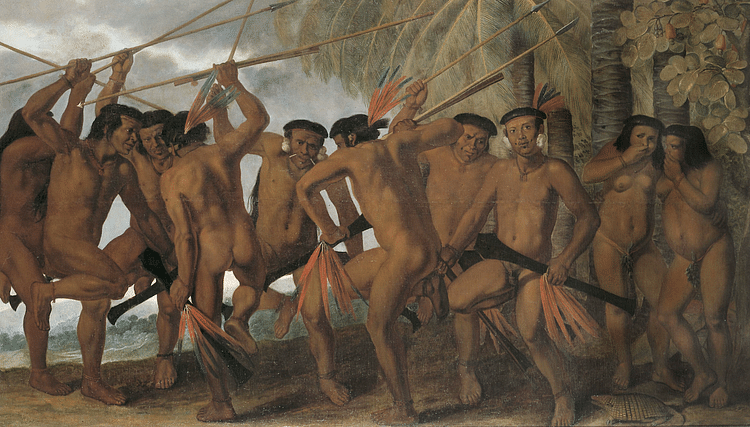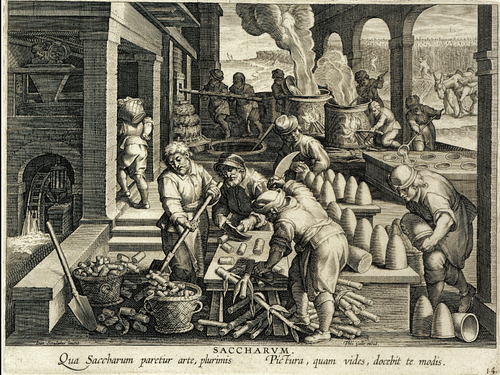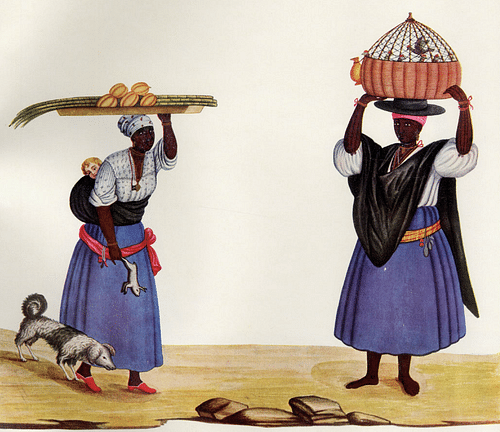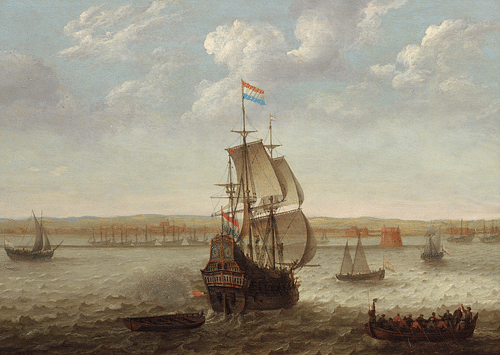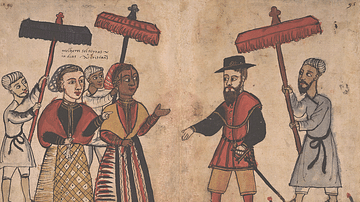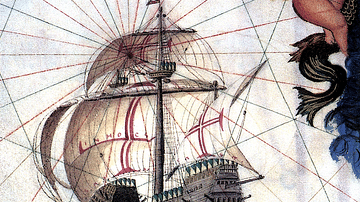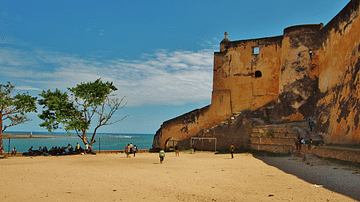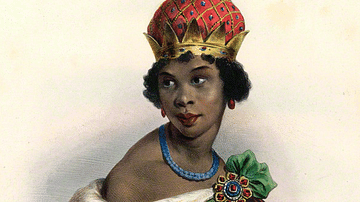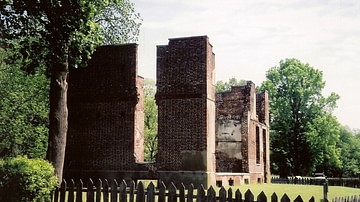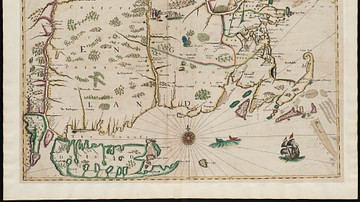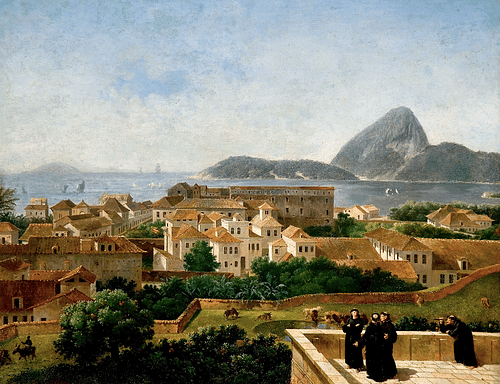
With a wealth of natural resources, Brazil was by far the most important colony in the Portuguese empire and was, at one time or another, the world’s leading producer of sugar, diamonds, and tobacco. Colonised from the 1530s, most settlements were coastal towns until the interior was exploited bringing further conflict with the Amerindians.
Importing a massive number of slaves from Africa, Brazilian society became multicultural but remained dominated by white Europeans. The colony was repeatedly threatened militarily and commercially by the French, Dutch, and British, but Portugal held on to its jewel in the colonial crown until Brazil achieved independence in 1822.
Europe Discovers Brazil
Vasco da Gama (c. 1469-1524) famously sailed around the Cape of Good Hope and on to India in 1497-1499, giving the Portuguese access to the spice trade of the East. The Portuguese followed this up by creating an empire of trading ports that went from East Africa to Japan. One of the by-products of da Gama’s epic voyage was significant for Brazil on the other side of the world. Da Gama had pioneered a new route to sail down the Atlantic Ocean to gain favourable winds. It was a risky strategy that involved sailing far out into the mid-Atlantic. When Pedro Álvares Cabral set off to repeat da Gama’s feat in March 1500, he sailed too far west and accidentally 'discovered' Brazil (although the visit may have been planned by the ever-secretive Portuguese). Cabral stayed eight days at Baia Cabrália where he met Amerindians. A Spanish sailor, Vicente Yáñez Pinzón had perhaps been the first European to sight the Brazilian coast the year before, but it is not clear where exactly he went. In any case, it was the Portuguese who claimed Brazil for their own because, as had been agreed with Spain in the 1494 Treaty of Tordesillas, it was within their sphere of influence. A second Portuguese expedition, led by Gonçalo Coelho, explored the Brazilian coast in more detail in 1501. Another famous explorer, the Florentine Amerigo Vespucci (1451-1512), visited in 1502, and he gives the following description:
This land is very delightful, and covered with an infinite number of green trees and very big ones which never lose their foliage, and through the year yield the sweetest aromatic perfumes and produce an infinite variety of fruit, gratifying to the taste and healthful to the body…and the fields produce herbs and flowers and many sweet and good roots, which are so marvelous…that I fancied myself to be near the terrestrial paradise.
(98)
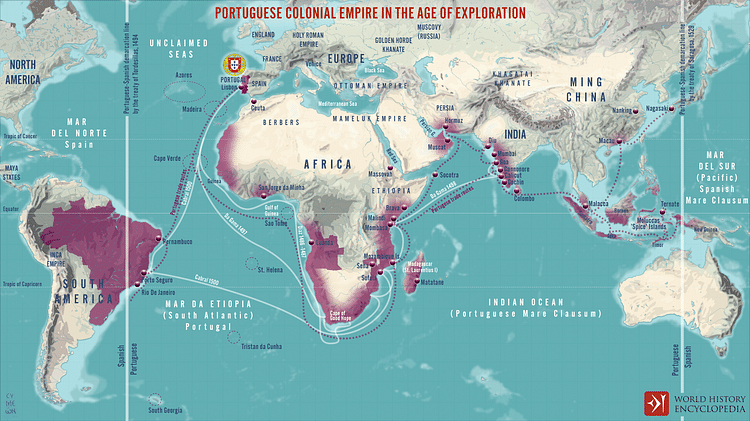
The name Brazil, which first appears on maps from 1511, may derive from 'Bresel wood' which was a popular hardwood of reddish colour exported from India to Europe in the Middle Ages. A similar type of wood was common in the forests of Brazil. Alternatively, the source may be brasa, the Portuguese name for this dark redwood and its dye which means 'glowing coal'. One of the early successful exports from Brazil was these hardwoods, used in everything from ships to violins. This timber attracted private Portuguese traders to Brazil from 1502 who established the first trading station (feitoria) north of Rio de Janeiro.
In 1511 the Portuguese Crown, wary of interest from Spain, made an official but secretive move on Brazil. João de Lisboa and Estêvão Froes commanded two caravel ships which explored the Brazilian coast. Spain sent a fleet to do the same in 1515. Both nations were looking for a route around the southern tip of the Americas and access to Asia. The Portuguese explorer Ferdinand Magellan (c. 1480-1521), in the service of Spain, was the first to achieve that feat on his 1519-22 expedition that circumnavigated the globe. Spain may have gained access to the Pacific Ocean, but it was Portugal that got to work on colonizing Brazil.
The Portuguese Move West
The first Portuguese settlement in Brazil was at São Vicente in 1532. Several hundred colonists came by ship to set up these colonies which grew in number along the Brazilian coast. Territories were handed out by the Crown in the form of 15 feudal grants or ‘captaincies’ which obliged the nobles, or more accurately, their vassals, to develop land for agriculture. The captaincy model had been used with success on Portugal’s North Atlantic island colonies, but colonial development was slow in Brazil. The quality of immigrants was low, with plenty of unscrupulous adventurers and social undesirables mixed in with the genuine settler-farmers, churchmen, and those seeking freedom from religious persecution like Jews and converted Jews (New Christians). Consequently, the Crown appointed a governor in 1549 to bring some order and push things along. Brazil was made an official Crown colony and the capital was established at Salvador da Bahia where a hospital, prison, cathedral, fortification walls, and customs house were built.
By the mid-16th century, the French had been removed as trading rivals, and in 1567, their fledgling colony of France Antarctique in Guanabara Bay was taken over. The settlement became Rio de Janeiro. By 1570, the colonial settlements were now taking shape, and the indigenous Amerindians were subdued and obliged to reside in controlled villages.
In 1572, a viceroyalty was established, like the one in Portuguese Goa for the Estado da India (the Portuguese Empire east of the Cape of Good Hope). The viceroyalty was divided into two parts, with Salvador as the capital of the north and Rio de Janeiro capital of the south (Rio became the single capital city in 1763). By the end of the 16th century, the Brazilian interior was being explored, mostly via rivers, and new settlements were established. In 1600, the Europeans in colonial Brazil numbered some 30,000. Threats still appeared from other European powers in the 1620s, mostly around the mouth of the Amazon River, but for the moment these incursions were easily dealt with by expeditions from Portuguese Belém.
The Amerindians
The Europeans were a little perplexed by the indigenous Brazilians. They seemed to have no property or ruler, no political system, no ranking in their society, and no belief in the soul. They lived according to nature, finding and taking all that they needed, which was very little, from the forest which was their home, although they did practise a rotation, slash-and-burn form of agriculture. Early explorers told of cannibalism, ruthless warfare between tribes, and even human sacrifices. Undoubtedly, the Europeans were unable to appreciate or comprehend the culture of these Tupi-Guarani Amerindians, as they came to be called by outsiders, but they had little interest in finding out. Just as in other parts of the empire, the Portuguese were here only to exploit the local resources, and only missionaries took an interest in the peoples who had lived across South America undisturbed for millennia and studied the native languages.
Peaceful and occasional trade relations with the indigenous population soon deteriorated into hostilities. The Portuguese subdued any Amerindians intent on warfare and attempted to use the more peaceful Amerindians as labour, but this was not a work Amerindian men usually did, and they easily escaped back to their forest at the earliest opportunity. The Portuguese used Amerindians captured by more friendly tribes as slaves, they launched their own slave-hunting expeditions and missionaries forced Amerindians to live in mission villages (aldeamentos) controlled by such organisations as the Jesuit Society. By the 1560s, Amerindian society was breaking down, tens of thousands had been killed by European diseases like smallpox, and most of those who remained free abandoned their settlements and moved far into the interior of Brazil; colonial expansion soon caught many of them up in a bloody war of extermination. In 1755, at least, Amerindians were recognised as full and free subjects of the Portuguese Crown, and the mission villages were disbanded.
Sugar Plantations & Slavery
The Portuguese had developed a successful plantation system to grow sugar cane in colonies like São Tomé and Principe. A labour-intensive crop, slaves had been brought from nearby West Africa to work on the plantations (fazendas). The system was then applied on an even larger scale in colonial Brazil from the 1530s where the availability of land was much greater. The first plantations were at Pernambuco, Sâo Vicente, and Rio. Within a few decades, Brazil had become the world’s largest producer of sugar. In 1570, Brazil had 60 sugar mills (engembos), by 1645, there were 350.
Slaves for the plantations were initially acquired locally, but from 1570, enslaving the Amerindians was prohibited. Most slaves, therefore, came by ship from Africa, particularly Portuguese Angola. Brazil was by far the largest importer of slaves in the Americas throughout the 17th century. When Brazilian sugar production was at its peak from 1600 to 1625, 150,000 African slaves were brought across the Atlantic. In the entire history of the Atlantic slave trade, around one-third of all slaves went in Portuguese ships to Brazil and for resale to Spanish colonies. One in five slaves never survived the horrendous conditions of transportation on board cramped, filthy ships. The voyage to Rio was one of the longest and took 60 days. African slaves had to learn the local language, creole Portuguese. More skilled labour came from immigrants, many of whom came from Portuguese colonies in the North Atlantic, which suffered badly from the large-scale sugar production in Brazil. Most of the sugar produced was shipped to Europe.
Trade, Gold & Diamonds
Carracks sailed regularly from Brazil to Lisbon carrying 125 kinds of products from tortoise-shell to topazes. Brazil, as noted above, was a massive exporter of hardwoods and also the dye from brazilwood (caesalpina echinata), which was deep red or even purple, and in great demand by cloth-makers in Europe. Hardwoods were the major Brazilian export until replaced by sugar in the early 17th century but remained significant until the 19th century when scarcity more than anything else saw this part of the timber industry decline dramatically.
It took a while to get going, but the gold exported to Lisbon from Brazilian mines, principally at Minas Gerais, became considerable. As the historian A. R. Disney notes,
By 1711 the annual amount of Brazilian gold legally shipped to Portugal had risen to almost 15,000 kilograms (33,000 lbs)…Suddenly Portugal was receiving from its prize overseas possession far more gold than any other imperial power had ever before extracted from a colony.
(Vol 1, 252-3).
As the gold rush continued at Minas Gerais, the annual output rose to a peak of over 30,000 kg and was never below 18,000 kg for the next few decades.
Manioc was a major crop in colonial Brazil, largely grown for the internal market to feed the population of slaves and free labour that worked on the plantations. Wheat was grown on a large scale around São Paolo. There were many great cattle ranches located on the periphery of colonial territory which provided meat, milk, leather, and fertilizer for the colony. From the end of the 17th century, tobacco was grown in significant quantities, an indigenous crop that required much less initial capital outlay than sugar cane. Tobacco from Bahia accounted for 90% of output as Brazil became the world’s largest producer, stimulated by the rising addiction of European, African, and Asian smokers.
From the early 1730s, Brazil was producing diamonds in significant quantities, challenging the world’s other major source, Madras (now Chennai) in India. Briefly in this decade, the annual diamond carats coming to Lisbon was 300,000 carats, four times greater than Madras’ exports to the whole of Europe. Indeed, production was so high, the Crown was obliged to severely restrict diamond mining in Brazil so that prices did not crash. All of these gold bars and diamonds made the Portuguese king, João V of Portugal (r. 1706-1750), probably the richest monarch in Europe. Unfortunately for the people of Portugal, most of the wealth was frittered away on lavish building projects or went to reduce the state’s chronic debts. The huge costs of maintaining a global empire and the country’s trade deficit were black holes that not even the riches of Brazil could fill.
Colonial Society
As elsewhere, colonial society in urban areas was dominated by large estate owners and merchants. There were also Portuguese soldiers, merchants, churchmen, artisans, and small-scale farmers, all eager to make a better life for themselves than was possible in an often impoverished homeland. There were, too, the degregados (undesirables) such as convicts, non-Catholics, and general misadventurers. There were immigrants from other Portuguese colonies, particularly the Atlantic islands, and European merchants from Britain, Italy, France, and other countries. There were, too, African slaves and the children of slaves (about one-third of the total population), and slaves who had won or bought their freedom.
As in other colonies, the limited number of European women resulted in a great mixing between races (Europeans, Amerindians, and Africans), more so in Brazil than any other Portuguese colony. Within each of these groups, there was another level of diversity as each category consisted of many different nationalities with different cultures and many African languages and Amerindian languages. The mixed-race offspring of these inter-relations were known as mestiços (mestizos). The mixed races and freed slaves struggled in society since not only did they have to combat daily prejudices but institutional racism existed in many forms. Africans, Amerindians, and mixed-race peoples found it extremely difficult to enter business since banks seldom offered them loans. Nor could they enter trades since they could not obtain a license. Non-whites, then, had to be content with low positions in society such as clerks, assistants in shops, barbers, or as labour on plantations. Many lived on the periphery of society, growing just enough food for themselves and their families on small plots of land or living on charity; many sank without trace below the poverty line. Nor could non-whites participate in the local government or câmera and so it was impossible to change the limits colonial, white-dominated society imposed on them.
The white elite made sure they maintained their exalted position through these discriminatory laws and by having their children only marry into other European families. It was not uncommon for wealthy white fathers to send their daughters to a life in a convent in Portugal rather than marry below their station in Brazil. The children of the white elite were sent to be educated in Portugal, since only a rudimentary education was available in even the largest cities in Brazil. This was another barrier that created a distinct and lasting ‘them and us’ divide in Brazilian society as a whole.
Dutch Attacks on Brazil
From the beginning of the 17th century, other European powers began to challenge Portugal’s empire. Ports were raided and shipping attacked, relieved of cargo, and sunk. Brazil was a target like any other, indeed, the colony had seen rival merchants, particularly the French, since the early days of its foundation. As Dutch and British maritime power increased, so, too, did their threat to Brazil.
The Dutch formed the Dutch West India Company (WIC) in 1621 to trade, plunder, and form new American colonies. In 1624, they captured Salvador but could hold on to it for only one year. In 1630, the Dutch grabbed Olinda and Recife and, in 1632, Pernambuco. They then occupied northern Brazil in 1635, and the Portuguese, keen to protect the best asset of their empire, were obliged to send an armada of 41 ships and 5,000 men in 1638. The Portuguese did not regain full control of Brazil until 1654 (largely thanks to the Dutch being distracted by a war with England from 1652), but the disruption to the sugar trade, in particular, had been significant.
The Brazil Company (Companhia Geral do Brasil) was formed in 1649 in imitation of the WIC. The greater and more centralised organisation of Brazilian trade the Brazil Company brought bore fruit and the introduction of a convoy system for ships sailing to Europe greatly reduced losses to marauding privateers. In 1663 a peace treaty was agreed between Portugal and the Netherlands, an agreement renewed in 1669. For 4 million cruzados (gold coins of the period), the Dutch agreed to renounce all claims on Brazil. It was not a huge sum, but it took the Portuguese 50 years to pay the debt. The territorial challenges to Portuguese Brazil were now greatly reduced. Instead, the preferred weapon of European powers was commerce.
British Involvement in Brazil
The threat from European rivals obliged Portugal to sign several other commercial treaties with their rivals from the mid-17th century onwards. The Portuguese signed the 1703 Methuen Treaty with Britain, which saw British capital allow trade in and from Brazil to boom. In 1711 France briefly took over Rio de Janeiro and Spain was nibbling away at southern Brazil. Portugal’s empire was fragile indeed, and a deal with the British seemed the safest option. Thanks to ever-increasing demand in Europe, by the mid-18th century, cotton, rice, cacao, and coffee were added to sugar, tobacco, and brazilwood as Brazil’s major exports. Further, Brazil was now a significant market for European goods like wine, olive oil, cereals, and wool cloth. The catch was that although Brazil remained in Portuguese hands, British traders were given certain privileges. These included the right to trade goods in Portuguese ports (except oil, wine, and cod) and to enjoy favourable duties on British imports to Brazil. Dutch and French traders were later given similar perks.
The consequence of this policy, albeit one forced on the Portuguese because of their lack of military power, was that more and more trade was lost to them. The situation was made worse with the decline in gold production and the development of rival colonial sugar plantations in the Caribbean and North America, dramatically reducing the customers for Portuguese-Brazilian products and pushing up the price of slaves. To try and redress the ever-sinking trade balance of the crown, sumptuary laws were passed preventing Portuguese-Brazilian citizens from buying certain foreign goods like glassware, porcelain, and textiles.
Independence
Brazil was beginning to act as a country in its own right in the 18th century. Recruits from Brazil, including Amerindians, were sent to help Portugal keep control of its more troublesome colonies such as Portuguese Angola. With them went native American foodstuffs which began to be grown in Africa. There was also direct trade going on between Brazil and Africa without the direct involvement of the Portuguese Crown.
Many Brazilians, inspired by the events of the American Revolutionary War (1776-83) and contact with some of its leaders, began to agitate for independence. Still, the colony was deemed secure enough for the Portuguese court, fearing its safety after France invaded Portugal in 1807, transferred to Brazil during the Napoleonic Wars (1803-1815). As it turned out, this move actually hastened independence.
Brazilians, eager for freedom from the taxation and duties imposed by the Portuguese government, and seeking equal rights for all citizens, achieved independence in 1822, rather oddly, declaring Pedro I (r. 1822-1831) as their king and the first Emperor of Brazil. Pedro was the son of João VI of Portugal (r. 1816-1826). Brazil thus became a monarchy in its own right, albeit with obviously close connections to the traditional Portuguese monarchy. The Portuguese remained involved in the lucrative slave trade with Brazil despite it being officially decreed illegal in 1836 by the Portuguese government. The trade did finally end in 1853 when the Brazilian government enforced its own ban on the entry of slaves. Made a republic in 1891, then suffering two periods of dictatorship from 1930-45 and 1964-69, Brazil became a democratic republic in 1985.
